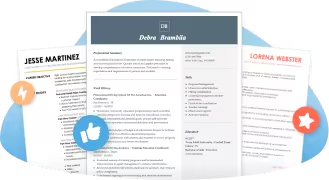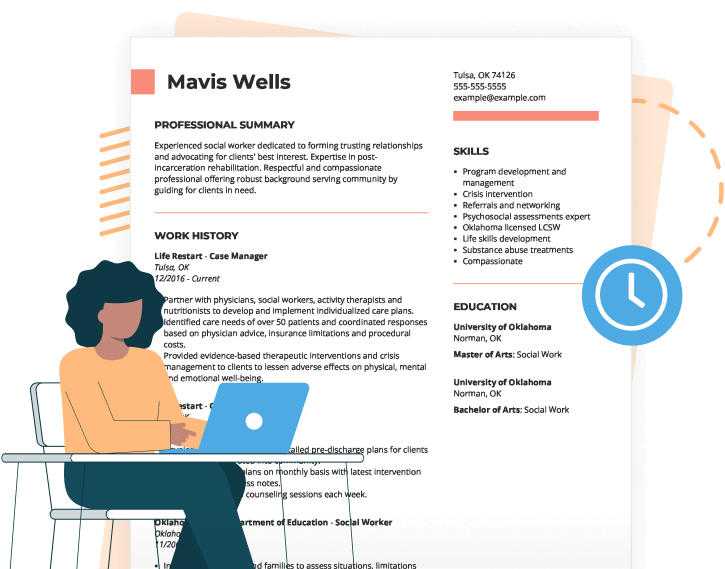Featured Resume Examples
Other top-requested library and museum resume examples are for library assistant, school librarian and library page. Searching for a different library and museum role? Keep going, we have plenty more below.
Search Library Museum Jobs
Library Museum Resumes by Job Title
Find the resume example you need by browsing these specific Library Museum categories:
Real Estate Legal Roles (1)
Customer Service Roles (1)
Educational and Technical Roles (13)
Leadership and Management Roles (3)
Supportive Roles (1)
Cover Letter Examples for Library Museum Jobs
Job Outlook
The world of library and museum work is full of opportunities and according to the U.S. Bureau of Labor Statistics, the right place to be.
Library work is expected to grow 5% during the next decade, as more communities turn to libraries for its services.
Meanwhile, the museum industry sees a more considerable growth at 11% up until 2029. This is due to the increasing demand for information storage in archives and the general public’s growing interest in science, art and history.
Your page is unwritten. It’s time to create the perfect resume to land the job you want. Luckily for you, we have professional writing tips below to help you get started.
3 Tips for Writing Library and Museum Resumes
Choose the Right Format for Your Library and Museum Resume
Deciding the correct resume format will come down to your years of experience and what you’re applying for. Let’s break it down.
If you have ten years of consistent employment in the library and museum industry, there are two options for you:
The chronological resume is the most well-known resume format. It’s usually on the shorter side, averaging one page for every ten years of experience that you have.
It focuses on your career progression, showing the hiring manager how you went from being a library volunteer to a librarian. It’s the easiest and most organized way to show your career growth through the years.
Because museum employment is a bit more competitive, some employers may request you to submit a CV instead of a resume.
CV is short for “curriculum vitae” and it’s a long and detailed document where you show everything you’ve done in your career. While not as popular as resumes in the U.S.,certain academic roles that may be found in libraries or museums prefer CVs to resumes.
A museum-oriented CV should have your accomplishments in research, publishing, productions, exhibitions, programs and projects.
However, if you’re fresh out of college or you’re changing industries, then the functional resume is the best fit for you.
A functional resume puts the spotlight on your skills, abilities and education instead of your scarce experience in the library and museum industry.
But if you’re in-between these three formats, with a few years of experience under your belt but less than five in total, then you might want to consider checking out the hybrid format.
It works just as it sounds.
The hybrid format combines the chronological and the functional formats to create a resume that shows off your skills while also giving you the space to describe your work history and growth within the industry. The hiring manager can see how you went from being a library volunteer to a library associate and that you’re on your way to becoming a fantastic librarian.
Once you’ve read the job application, choose the format that works for you. From there, you can get started on your resume by looking at the list of skills below.
Promote Sought-After Resume Skills
The next step in perfecting your resume is determining the skills that show what a well-rounded candidate you are.
We know that each role in the library and museum industry is unique and not all of them share the same responsibilities, but there are several skills that all hiring managers want to see.
Check out the list below and see which ones you can use:
- Highly organized
- Thorough researcher
- Strong self-discipline
- Problem-solving
- Team player
- Education-focused
- Strong communication
- Historical knowledge
- Flexibility
- Maintaining accurate catalogs
- Data entry
- Giving presentations
- Attention to detail
- Digital archiving
- Cataloging
- Document archival
- Material preservation
- MARC records
- Project management
- Digital curation
- Shelving
- Documentation
- Customer care
- Art appraisal
- Acquisitions
- Exhibit design
- Order keeping
- Authentication
- Rare document conservation
- Preventative maintenance
- Database research
Add a mixture of these skills in your resume — between six and eight — to show the hiring manager you know what you’re doing.
Use a template to make your resume look professional
Helping people get the information they need and maintaining valuable artifacts is essential for someone who works in the library and museum industry. You need a resume that not only organizes everything well but also looks professional.
At JobHero, we have a large selection of professional and modern resume templates just a click away.
Our Resume Builder is extremely easy to use and will guide you along the way with suggested keywords, marks under any spelling error, and small suggestions that will get your resume from a rough draft to a completed work of art.
Whether you’re a public librarian or a museum curator, your resume needs to show that you’re a beacon of knowledge. It needs to efficiently store all your information so that you can present yourself in the best way possible.
Fortunately, by the end of our guided tour, you’ll have a resume that’s too good to miss.
FAQ
How do I work in a library or museum?
While there are entry-level positions to begin working in this industry, higher education is a requirement in most senior levels and some roles even require a teaching certificate, depending on the state.
For example, librarians are expected to have a master’s degree in library science, while school librarians must have a master’s degree and a teaching certificate. Some schools also require librarians to pass a standardized test.
A master’s degree in a related field is necessary to work in a museum though there are plenty of internships and volunteer opportunities to gain experience.
Your specialization will all come down to what you want to do.
An archivist needs a master’s in history, library science, archival studies, political science or public administration. But curators should have a master’s in art history, history, archeology or museum studies.
Although certificates are not necessary to work in a museum, some archivists still choose to earn one because it allows them to show expertise in their area.
If you have certifications, learn how to include them in a separate section of your resume.
Is it hard to work in a library or museum?
Librarians and museum workers love what they do!
Most librarians work full-time and are on the floor with patrons, helping them with whatever they need. Sometimes they work on weekends, evenings and most holidays, but it depends on the type of library they work in.
Likewise, most museum employees work full-time, as well. Their time is divided by desk work and being with the public, providing assistance and educational services.
How much do you get paid working in a library or museum?
The library and museum industry is growing at an above-average rate.
According to the U.S. Bureau of Labor Statistics, people who work in libraries earn an average annual income of $59,000. At the same time, museum employees have a solid-salary of $49,850.
The numbers and growth are good. More library and museum employers look for people just as passionate as them about science, history and literature. Show them you’re the person they’re looking for by building a top-notch resume with our Resume Builder.
Our builder will help you create a resume that looks professional and up to date with the latest trends, putting you a couple of steps ahead of the competition.
What are the duties and responsibilities in a library or museum?
Let’s divide it up so you can understand it better.
Librarians help people find the information they’re looking for and conduct research. The specific duties of a librarian will depend on the type of library they work at — public, school, medical, law, etc. — but overall, librarians:
The responsibilities of museum workers will vary from job title to job title. Archivists appraise, process, catalog and preserve records; curators oversee art and historical collections, and conservators are responsible for restoring objects.
There’s a lot to do in the library and museum industry. It’s an exciting world with endless possibilities.
Should I include a cover letter with my library or museum resume?
You definitely should!
Submitting a cover letter with your resume, even if the job posting doesn’t ask you to, will only help you look more professional because it shows you went above and beyond.
A cover letter gives you even more space to discuss your skills, experience, and your passion for what you do. You also have a chance to tell the story of an achievement, be it a successful exhibition or a heartwarming anecdote with a library patron.
Including a cover letter will allow you to show the hiring manager that, like an art piece or a good book, you’re valuable and irreplaceable.
Get started with yours by checking our selection of library and museum cover letter examples.







